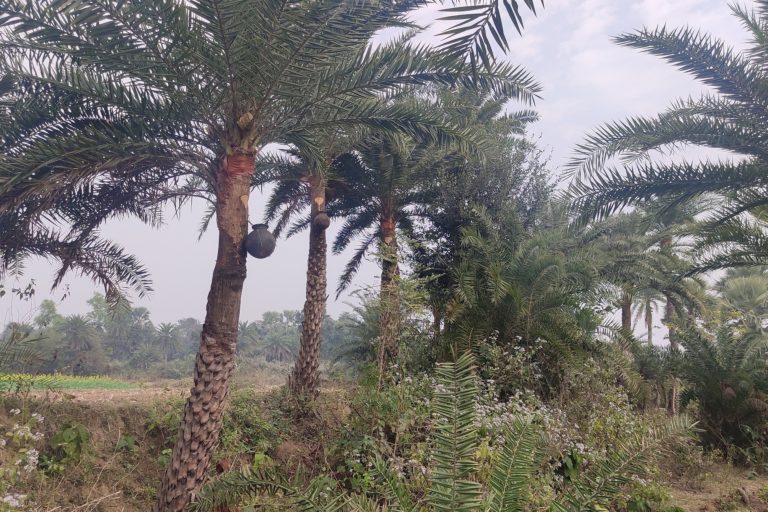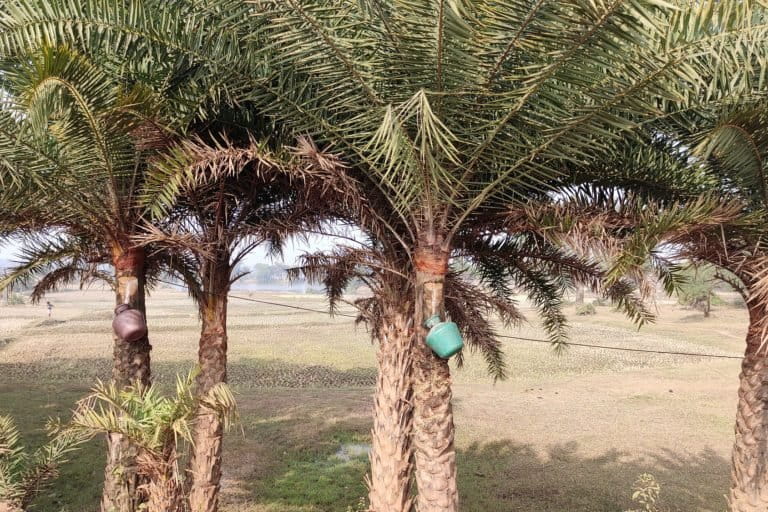- Two palm species, date and palmyra palm, grow extensively in Bankura, Purulia, Jhargram and West Midnapore districts of West Bengal, because of the favourable climatic conditions.
- Villagers in Bankura district of Bengal are earning their livelihood by collecting sap and running processing units for making jaggery and other items.
- To ensure a sustainable future, experts advise expanding into new markets and thinking of innovative products besides jaggery.
Sukhdeb Mandy is a sap tapper at Aambera village in Bankura district of West Bengal. The 28-year-old collects sap from date palm trees during the winter season. During the rest of the year, he does farming and odd jobs for his livelihood.
Mandy, who hails from a tribal community, claims that he earns around Rs 500 every day by collecting sap from 100 trees and selling each earthen pot filled with the liquid for Rs 5.
“The sap collection is a profitable venture during the winters and income depends on the speed with which sap can be collected during the morning hours after climbing up the trees. Most of the youths who work in other areas return to their villages to work as sap tappers. They earn a hefty amount during the season of date and palmyra palm trees,” he said while fastening the earthen container to the flower stump to collect the sap.

From sap to money
But Aambera village is not alone. Over 300 villagers living in Sarkarkanali, Tantihir, Khairgenjak, Ramkrishnapur and Musunia in Onda block are not only working as tappers, but have also set up their processing units for making jaggery and other items out of the sap.
Almost all the palm trees are located on the community land and the owners strike a deal with the sap collectors to give them a portion of the yield in exchange for allowing them to use the trees.
“We usually bargain for two kilos of jaggery from each tree or charge Rs 100 per tree from where the sap is collected. We cannot climb the trees for sap and leasing it to tappers brings us a ready-made income,” said Santiram Sahana (53), a landowner in Aambera village who has over 50 trees.
The landowners are unanimously against cutting the trees and using it for commercial purposes. “The villagers are not very keen to chop the trees as they consider it to be their sources of income. The number of trees has increased in the district over the past few years,” pointed out Shibdas Sahana (66), who resides in the same village.

Bankura, along with adjoining Purulia and other districts of West Bengal primarily has two species of palm, date and palmyra, thanks to favourable climatic conditions.
The season for extracting sap from palmyra palm begins from 15 March to 10 June, while for date palm, it is 15 October to 15 January. The date palm takes 10-12 years for producing sap, while the time taken by palmyra palm is 12-15 years.
In terms of productivity, palmyra gives 4-5 containers of sap at a time, while for date palm, it is just one container.
During the same period, processing units make jaggery related products from the sap. “Soon after the collection, the sap is being filtered and boiled and then measured to ensure that the pH level of 7 is maintained, as higher or lower levels of pH would make it unfit for consumption. It is re-filtered and boiled until the level comes to the permissible limit,” says Pintu Mondal, 30, who runs a processing unit and also doubles up as a tapper.

He claimed to earn around Rs 1 lakh during the season from the unit, “Earlier, there were just 2-3 units, but now it has swelled to 30 in just Aambera and neighbouring villages are also busy setting up their units. The sap has not only opened new avenues of livelihood but has also thwarted people from cutting down trees,” he added.
Shankar Soren, who lives in the neighbouring Ramkrishnapur village said that he started his processing unit last year, “Earlier, I used to work as a labourer in Kolkata but returned after I realised that sap can be really profitable. I have opened up my processing unit for making jaggery, which is sold in local markets.”
Non-profits and government promoting palm
Local NGOs are training villagers to diversify into different products from solid jaggery. “We have been working closely with the villagers for alternative livelihoods since 2012. Earlier, the villagers were making solid or liquid jaggery, but now they have been trained to make candies, palmyra syrup, sugar, barfi (Indian sweet) and other items. We have made a tie-up with the processing units, who supply us the products which are then sold in Bengal and other parts of the country. We are also planning to make non-edible products from the palm, like fans and mats,” said Dipak Ghosh, district unit in-charge of Development Research Communications and Services Centre (DRCSC), a non-profit working for sustainable agriculture and alternative livelihood.

He further said that the demand for the products has been rising and around 10 tons of jaggery products were sold in 2019-20 as compared to 5 tons in the preceding year.
Even the West Bengal government is keen to promote the palm and offer livelihood to people. “The palm has a huge potential wherever it grows across the state. We are going to plant Arabian date palm seedlings on pilot basis, processed from Gujarat. Around 400 seedlings would be planted, including one hundred on government land and the rest on the land of beneficiaries to find if the plant survives in these climatic conditions. The plant is expected to yield around 15-20 kg of the fruits once it reaches the production stage after 2.5 years. The production would increase to 40 kg in 5 years when the tree reaches its optimum stage. The farmer can earn around Rs 40,000-50,000 by just selling the fruits if the plantations are successful and Arabian date palm grows here,” said Dr Malay Majhi, deputy director of horticulture of Bankura district.
Paving the way for entrepreneurship
Environmentalists, however, have expressed happiness over the non-cutting of trees but are equally concerned about earthen pots being increasingly replaced by plastic containers for sap collection, “It is really nice to witness people understanding the value of nature and how it can generate income for them. Even a few years ago, people considered date and palmyra trees as waste, but now the mindset has been changing for good. But the increasing use of plastic containers instead of the age-old earthen pots is a cause of concern. Tappers are switching to plastic because they are light-weight and easy to handle while climbing up the trees for the extraction,” said Priyanath Haldar, an environment enthusiast and a retired professor from Sidho Kanho Birsa University, based in Bankura district of Bengal.
“But the plastic containers are not properly cleaned before being suspended from the trees and the sap has the danger of turning acidic despite being boiled at high temperatures. Plastic is of cheap quality that impacts the quality of the sap,” he added.

He also pointed out the increasing use of tyres and other harmful waste as fuel for making jaggery in processing units, “The toxic emissions are spreading poisonous gases in the air that could lead to the spread of diseases. As the sap collection is turning out to be a profitable affair, most of the outsiders are settling in Bankura and using hazardous materials as a fuel for their units. The changing climatic conditions and reduction in the chill are also impacting the quality of sap,” he said.
The future of sap tappers depends upon expanding into new markets and thinking beyond jaggery, feel experts. “It is very necessary to make new products from jaggery to attract the young generation. Apart from West Bengal, jaggery products have a good demand in other states. The government should make serious interventions in creating new markets that would not only add fresh sap tappers to the list but would also churn out entrepreneurs from them,” signed off Haldar.
Related: Tharuvaikulam’s palmyra climbers turn sustainable fishers
Banner image: Sukhdeb Mandy, a sap collector, on a date plam tree in Bankura district, West Bengal . Photo by Gurvinder Singh.
